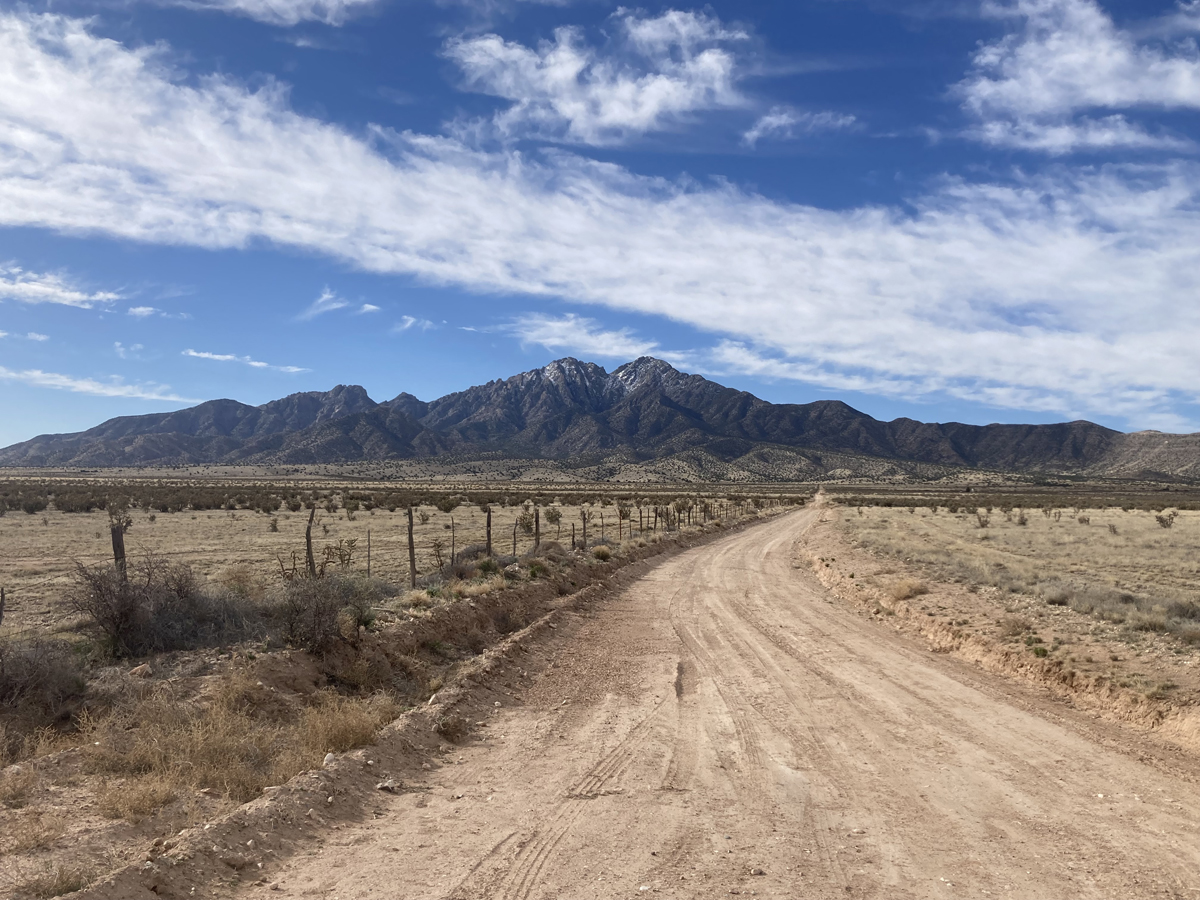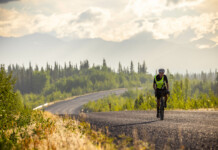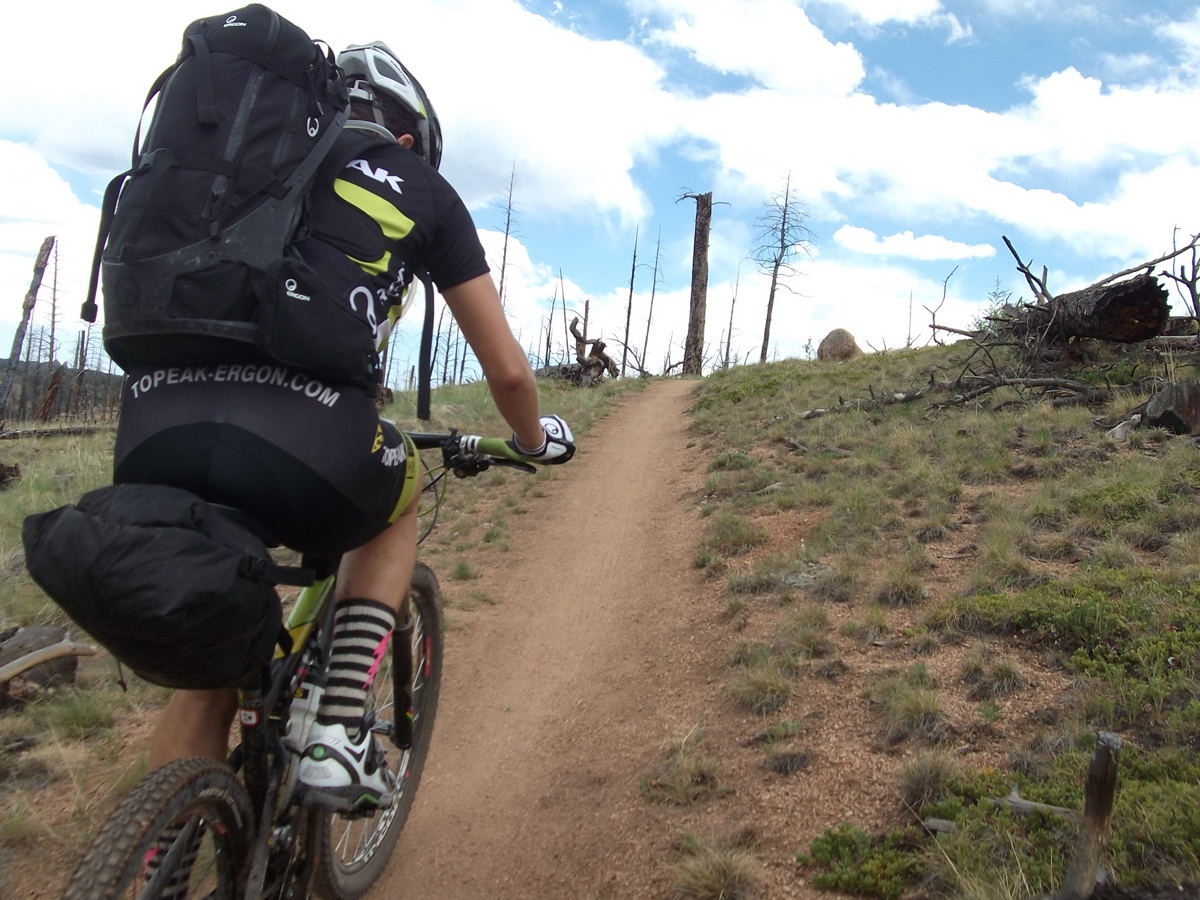“If you want to know who you are, you must look at the mountain.” —Charles Bowden
By Don Scheese — Is there a distant mountain on your horizon that intrigues and allures you? To the southwest of Albuquerque, some fifty miles distant, rises the jagged, isolated mini-range known as Sierra Ladrones, or “Thieves Mountain,” elevation 9210’. So named because of the frequent raids by Navajo and Apache warriors of Spanish settlements along the Rio Grande in the nineteenth century who retreated to and vanished in the reclusive canyons of this montano, Sierra Ladrones remains a seldom-visited area for recreationists. The mountain has been designated a Wilderness Study Area (WSA) by the Bureau of Land Management, but no official trails or campgrounds exist and climbing the peak involves a daunting, dangerous nine-mile roundtrip bushwhack and ridge scramble to reach the summit of its jagged crest. Generally ignored by passers-by in favor of more popular official wilderness areas such as the Manzanos, Sandias, and Sangre de Christos, Sierra Ladrones remains an obscure sanctuary for the wilderness aficionado. Exactly the reason I found it alluring.
I had for some time considered a bikepacking excursion in the vicinity of the mountain, and in early April 2024 I found conditions to be ideal for a visit—70s for highs, 40s for lows, clear skies, light winds (at least until a cold front blew in late on the day I was to depart). From the village of Bernardo off I-25 (formerly named Picacho, or peak, because it lies in the shadow of the Ladrones massif), I planned to ride twenty-some miles on gravel county roads to the divide which separates the drainages of the Rio Puerco (dirty river) and the Rio Salado (salty river), and find a wild campsite far enough from the main road so as to be unnoticed by passing traffic. Not that there was much chance of that—the only habitation between Bernardo and the town of Magdalena, fifty miles distant, is the ghost town of Riley about halfway, another one of those tiny, isolated communities for which New Mexico is well known.
Around 10:30 on a gorgeous New Mexico morning I loaded up my trusty, bombproof steel Niner RLT with racks, panniers, bar bag, fork cages with water bottles, and Camelbak, and set off, carrying about seven liters of water and thirty pounds total (as far as I knew, no water sources existed along or near my route). What traveler is not familiar with the exhilarating first few steps (or in this case, wheel revolutions) of a journey, however long or short? “Of all the wonders of the world,” once wrote traveler extraordinaire Freya Stark, “the horizon is the greatest.” Indeed.
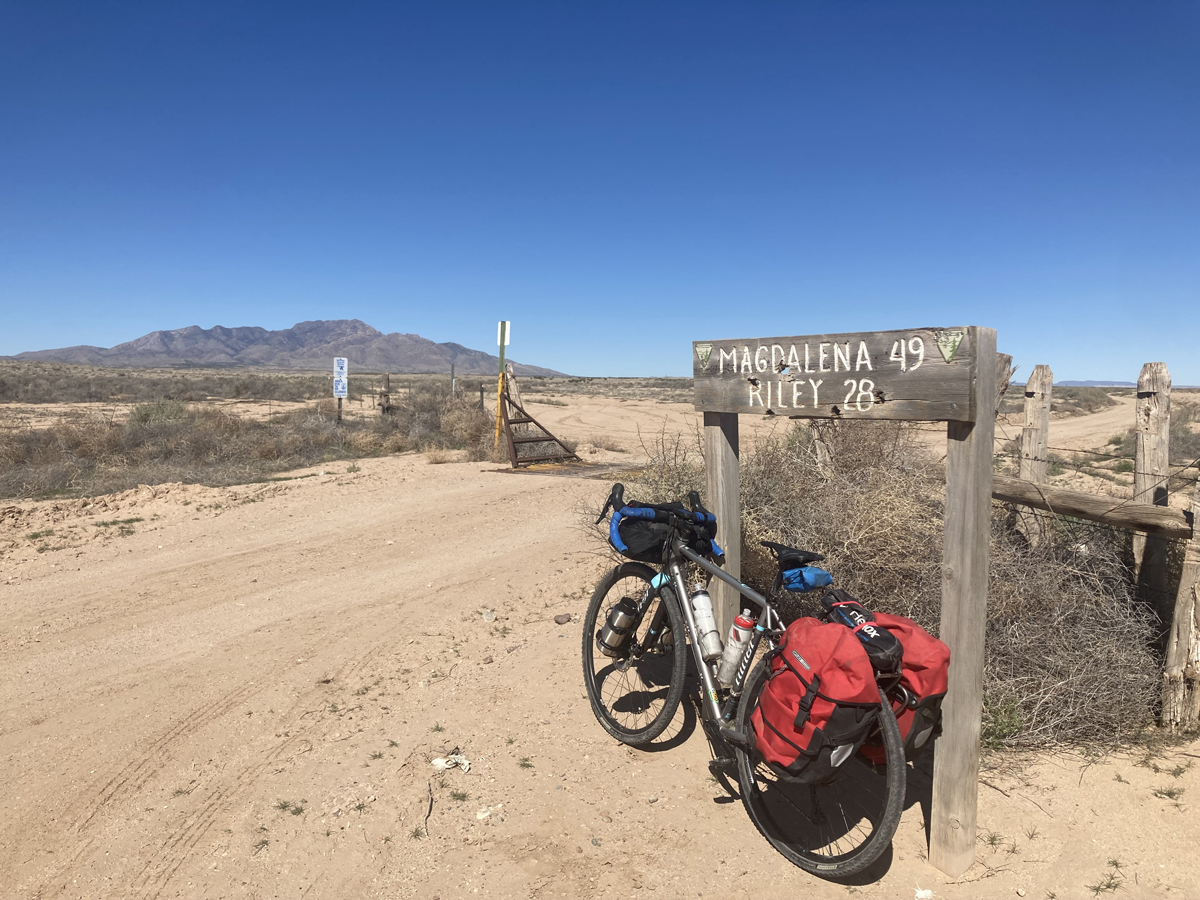
And the horizons were indeed awesome: vast desert plains stretching in all directions, rising to the snow-capped ranges of the Magdalenas, Manzanos, Sandias, and even a bit of the Sangre de Christos, dim with distance, to the far north. Closer were the snow-filled crevices of Sierra Ladrones itself, beckoning me onward. It was going to be an exceptionally good day …
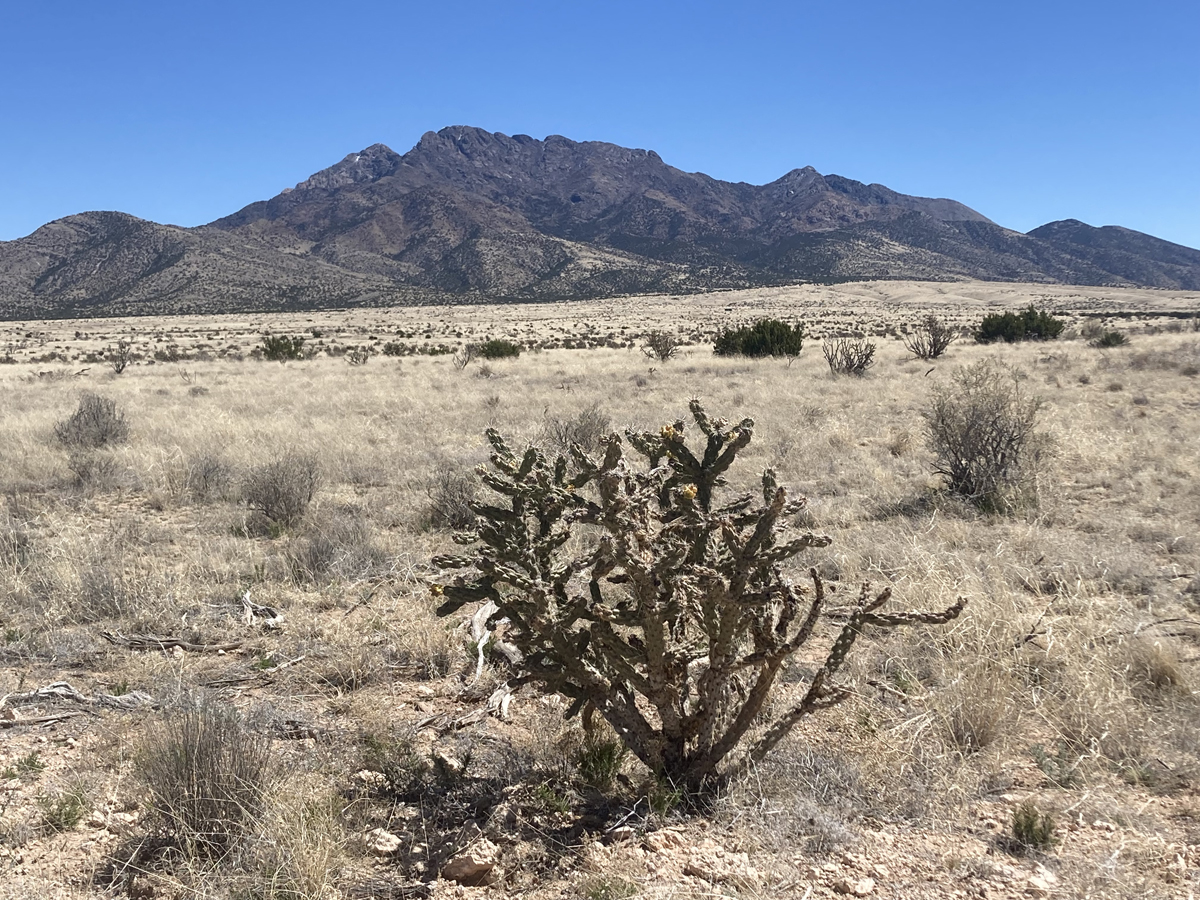
… except for the first few miles of sandy washboard I had to negotiate on a heavily loaded bike. The going was hard, lending new and arduous meaning to the verb “to trundle,” and more than once I almost had to put a foot down after getting mired in sand and slowed to a 2-mile-an-hour crawl because of bumpy washboard. But, as on all journeys, especially by bicycle, the road surface never stays the same for long, and soon I climbed out of the wide arroyo and creosote flats onto smoother, almost “champagne gravel.” The gradient decreased, and I found myself moving at a comfortable 10 mph pace on mostly straight road with an occasional dip and climb into and out of several shallow arroyos, almost imperceptibly ascending towards the divide.
The first and only vehicle I encountered was a pickup with two guys pulling a trailer loaded with gear and covered by a blue tarp. They were heading for a long weekend to their ranch near Riley and stopped to chat.
“Taking a trip?”
“Yeah.”
“Where to?”
“Oh, I don’t know, wherever I end up I guess.”
“Well, have a good one.”
“You too.”
The brief conversation reminded me of the opening scene from one of my favorite TV shows of all time, Then Came Bronson, which aired for one season in 1969-70. Bronson (played by Michael Parks) was a disillusioned journalist from the Bay Area of California who gave up his job after a friend committed suicide and set off on his Harley Davidson Sportster to “find himself” and visit friends all over the American West. He meets and spends time with astrologers and mystics, back-to-the-landers, angry black militants, an Amish family, Hispanic migrant workers—a wide cross-section of the populace, respectfully listening and learning all the way. I trace my sense of wanderlust to this TV show, which struck a fundamental chord in my psyche that has sounded ever since.
Onward, onto the next ecological zone—the cholla-grassland biome. LGBs (little gray birds) sprayed from the brush, as a nice tailwind pushed me higher on the plain. Ahead on the road I detected movement, and sure enough a herd of a dozen or so antelope pranced across the byway, white rumps flashing in the sunlight, trailed by a majestic pronghorn buck. They trotted off, then stopped out of curiosity to peer back at this strange figure moving along the road.
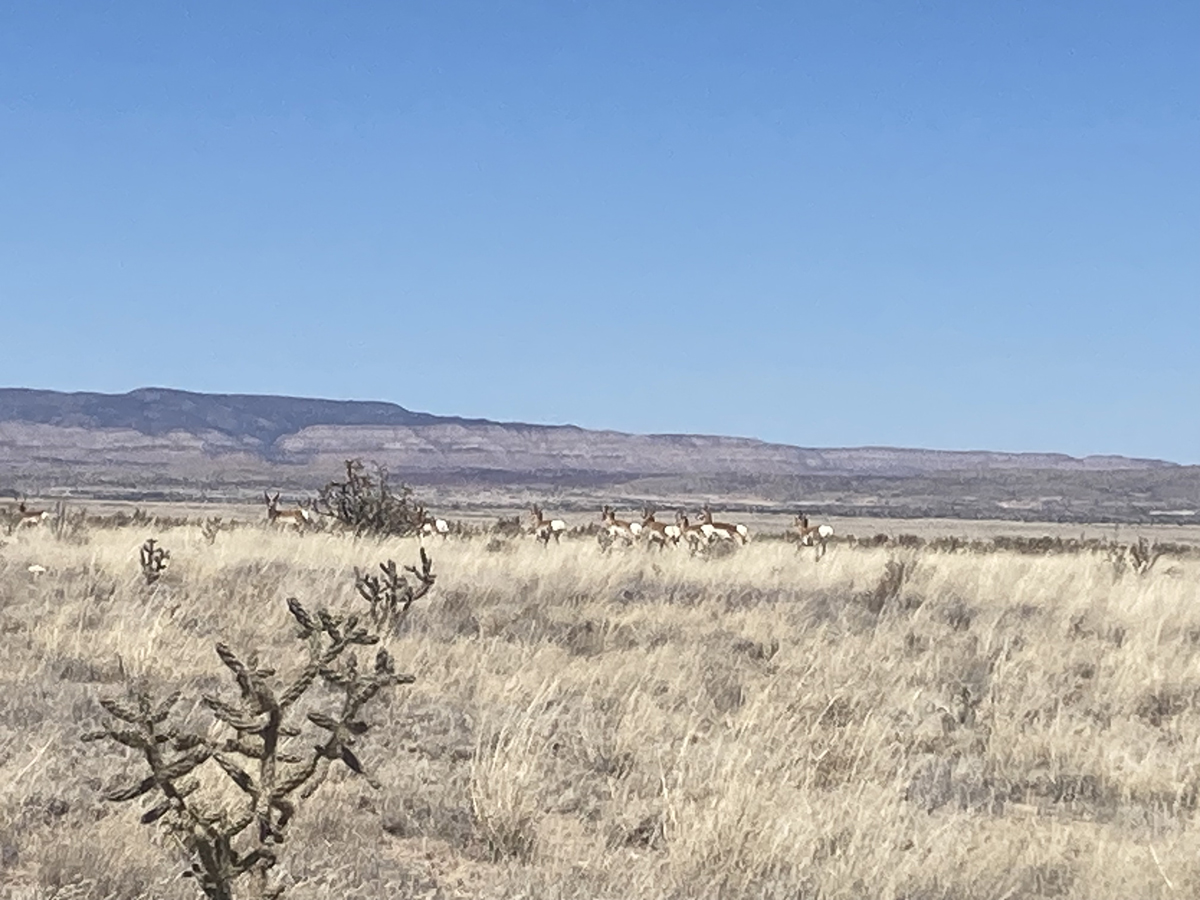
Counting the cattleguard crossings—was that five or six?—at last I began a steeper ascent around mile 15 as the road curved through a cleft between mesas, entering yet another ecological zone, the pinyon-juniper forest. Except that there weren’t too many live pinyon trees around, casualties of the Mega-drought afflicting the Southwest for the past twenty-some years. I sadly noted the gray skeletons of numerous pinyon pines, testament to Climate Change. Foreboding warnings, for sure, of the fate of our current civilization. Ah, but cultures come and go—just ask the Anasazi.
Around mile 19 I encountered a sign, marking a fork in the road: Limited Travel, no motor vehicles allowed on the left, more primitive road.
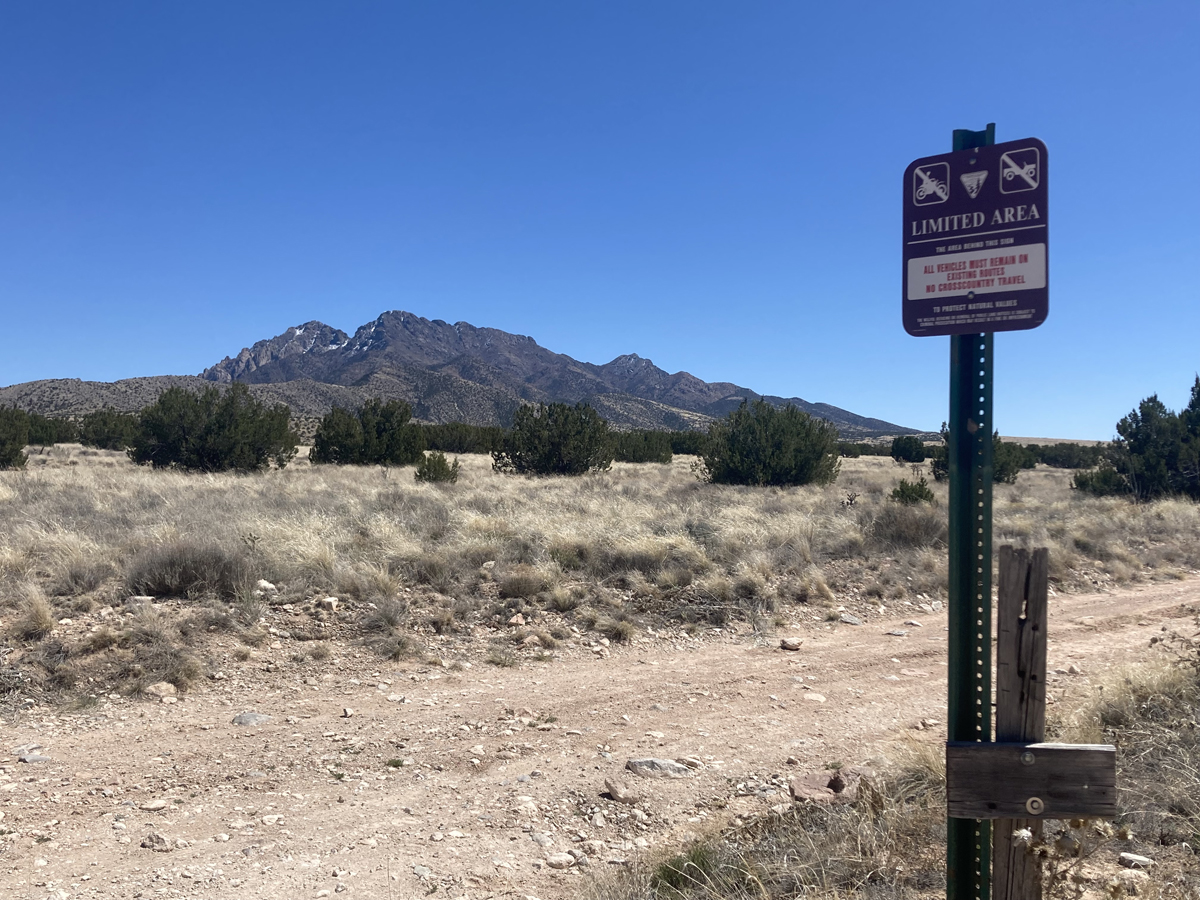
The less-traveled path—that’s the one I wanted, leading along the border of the WSA towards the mountain. It turned out to be a navigable two-track road with my 42mm gravel tires, and I gently climbed still higher almost onto the flanks of Sierra Ladrones, just about on the crest of the divide. In a mile or so I came to a small clearing between the junipers and a fire ring–an old cowboy camp, I reckoned. Here, mid-afternoon, is where I took my stand, and made camp. Elevation 6100’. I’d come a little over 20 miles, climbed 1600’. It had been a good day.
The sun was unrelenting, one of those rare spring days with not a cloud in the sky, and I sought relief from it as well as the temperatures, which must have been near 70. Behind a tall wide juniper, I found shelter from both the sun and the wind, and set up my mini-Helinox chair, a luxury I can’t afford not to take while bikepacking—the extra weight of two pounds well worth the comfort and back relief it provides while in camp. The rest of the afternoon I munched pistachios and sipped water, taking in the pleasing prospects in all directions, listening to the caress of the wind through the junipers, watching the occasional tumbleweed dance across the grassland, absorbing the Sounds of Silence. Inevitably I thought of some lines from Whitman:
“I inhale great draughts of space,
The east and the west are mine,
And the north and the south are mine.
All seems beautiful to me.”
Recently I read an article entitled “Shhh. Travelers are on a quest for the quiet.” The author writes that “From serene nature retreats to silent walking, the quest for quietude has become one of modern travel’s latest trends.” She goes on to say that people pay big bucks for “transformative travel” to exotic locales around the globe, choosing from environmental options like “Polar,” “Desert,” “Coastal,” “Jungle,” or “Mountain.” For as long as the human species has existed, I believe, we have sought out quiet spots and experiences, in search of The Transcendent. And we need not spend thousands of our hard-earned dollars to find it.
I found myself looking again and again at The Mountain. In a way it reminded me of the isolated volcanoes of the Pacific Northwest, where I used to live. But Sierra Ladrones is a metamorphic, not volcanic, peak, its rocks squeezed and thrust upward during millions of years of compression, uplift, and erosion. Now that I was close to it, it mesmerized me even more, making me wonder who has visited it, where the Navajo and Apache hid in its recessive, rugged canyons, when and where hard-rock miners probed its harsh niches for gold and silver. In this era of Environmental Apocalypse, we fear for the “End of Nature,” but the truth is that The Mountain will be here far longer after humans disappear. Species come and go, but the earth, in some form or another, will endure.
Dinner: a cup of chicken noodle soup followed by cold black bean burritos. A dessert of hot chocolate laced with a splash of whiskey. As the sun began to set in the northwest and the wind died down, I set up my tent and watched the day come to a close. 7:28 pm: A mildly colorful sunset, enhanced by high cirrus clouds. It was followed by the slow appearance of stars and constellations, the blackest night sky I’ve seen in a while on this moon-less night. A cold camp—I made no campfire because it was too windy, and didn’t want to risk a million-acre wildfire in these still brisk and dry conditions.
I emerged from the tent around 6:30 to witness the unfolding world as the sun slowly lightened the western horizon. High clouds stretched across the sky, helping to create a gory sunrise—and I thought of that old truism “Red sky in the morning, sailors take warning”—as I fired up the stove for coffee.
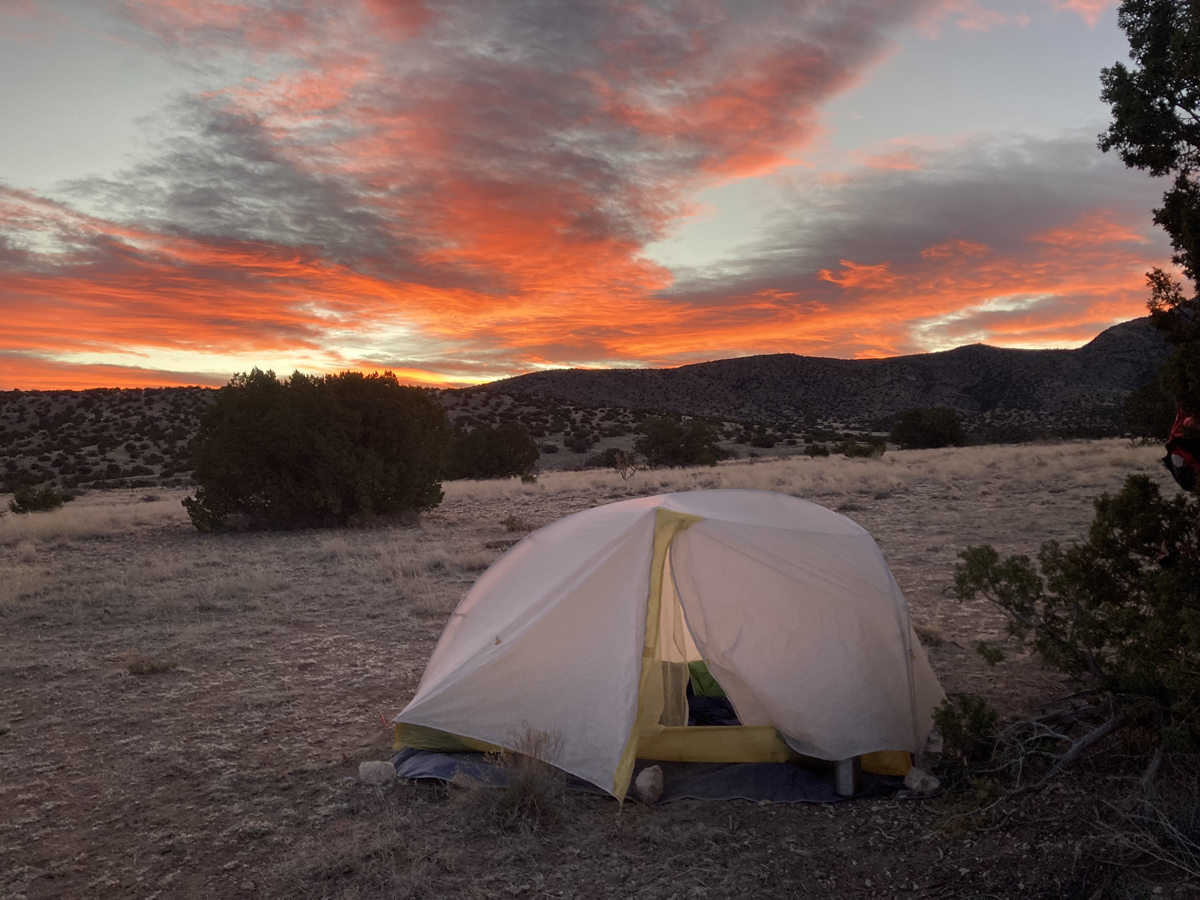
The sun peeked over the northwest ridge of Sierra Ladrones at 7:20 am, and unconsciously I engaged in one of the oldest of human traditions: marking well sunrise and sunset. Sipping coffee, munching on a chocolate croissant and a banana, relaxing in my chair, listening to the chittering birds, I thought of Emerson: “I enjoy a perfect exhilaration. I fear to think how glad I am.”
Another age-old tradition followed: the breaking of camp. The wanderer must return home or continue traveling. The reward for my efforts yesterday was a marvelous 20-mile descent back to Bernardo today. The winds started to accelerate, and I got an alert on my Garmin: Wind Advisory, Red Flag Alert, starting around noon. With any luck I’d have a tailwind at least to start with the wind coming out of the southwest. So, I bade adieu to my camp and thanked the spot for allowing me to spend the night there in peace and safety. Then, reminded of that endearing bike traveler and Man-Child Ryan Van Duzer, I chanted: “No Crashies, No Flatties, No Whammies!” The mantra for the morning.
What a glorious descent it was, freewheeling back down the road at a steady 20-25 mph. About half way back I met up with a fellow bike traveler, Emmett, from Pittsburgh, PA, who’d been On the Road for 30-some days, mostly riding pavement on his old steel beater with balloon tires, fenders, racks, and Army surplus packs. A strapping 20-something, with double nose-ring and cheerful disposition, he seemed content with meeting whatever conditions arose, having trundled 2000 miles already. His final destination was San Francisco. Having spent the previous night around Albuquerque, he was taking the southern route across the Southwest from Las Cruces, detouring on these backroads to avoid the interstate highway. As fellow travelers (he on a truly Epic Trip), we exchanged info and wished each other well. Es para el Camino: It is the Way of the Road.
Farther down I encountered a guy in a pickup who stopped to chat. Rich from the ABQ metro area owns 40 acres near Riley, another landowner in the Outback headed to his weekend retreat. He wished the county graded the road more often—“Those awful washboards down the road!”—and told me about the rattlesnakes he’d killed on his property that had bitten his and his neighbor’s dogs. They come out in late May and stick around till September, he informed me. “What I like about out here is, no sirens or gunshots,” he said. He has a conceal-and-carry permit for his 9mm but rarely needed it in these parts, only for shooting poisonous snakes (I resisted the urge to lecture him on the ecological importance of all wild creatures, including poisonous reptiles). Back in ABQ it was a different story. “What a world we now live in,” I remarked, and he agreed, wholeheartedly. Oh, the trials and tribulations of what Ed Abbey referred to as “syphilization.” Rich could have easily talked for another hour, but I told him I needed to move on before the winds got much stronger.
And they did. Around ten miles to go, I turned more towards the south-southwest, into a headwind. And the uphills on the arroyo crossings reminded me that it’s never really “all downhill” as we like to think. I grinded away, eventually descending back onto the creosote flats, and sometime later caught the glint of a vehicle in the sunlight ahead. That was my car, still intact, ready to take me home. Without provocation, the theme song from Then Came Bronson came to mind:
“Going down that long lonesome highwayBound for the mountains and the plainsSure ain’t nothing here gonna tie meAnd I got some friends I’d like to seeOne of these days I’m gonna settle downBut till I do I won’t be hanging roundGoing down that long lonesome highwayGonna live life my way”
